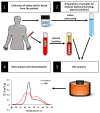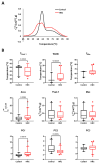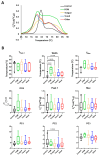Evaluation of Thermal Liquid Biopsy Analysis of Saliva and Blood Plasma Specimens as a Novel Diagnostic Modality in Head and Neck Cancer
- PMID: 39766119
- PMCID: PMC11674294
- DOI: 10.3390/cancers16244220
Evaluation of Thermal Liquid Biopsy Analysis of Saliva and Blood Plasma Specimens as a Novel Diagnostic Modality in Head and Neck Cancer
Abstract
Background: Over the past decade, saliva-based liquid biopsies have emerged as promising tools for the early diagnosis, prognosis, and monitoring of cancer, particularly in high-risk populations. However, challenges persist because of low concentrations and variable modifications of biomarkers linked to tumor development when compared to normal salivary components.
Methods: This study explores the application of differential scanning calorimetry (DSC)-based thermal liquid biopsy (TLB) for analyzing saliva and blood plasma samples from head and neck cancer (HNC) patients.
Results: Our research identified an effective saliva processing method via high-speed centrifugation and ultrafiltration, resulting in reliable TLB data. Notably, we recorded unique TLB profiles for saliva from 48 HNC patients and 21 controls, revealing distinct differences in thermal transition features that corresponded to salivary protein denaturation. These results indicated the potential of saliva TLB profiles in differentiating healthy individuals from HNC patients and identifying tumor characteristics. In contrast, TLB profiles for blood plasma samples exhibited smaller differences between HNC patients and had less utility for differentiation within HNC.
Conclusions: Our findings support the feasibility of saliva-based TLB for HNC diagnostics, with further refinement in sample collection and the incorporation of additional patient variables anticipated to enhance accuracy, ultimately advancing non-invasive diagnostic strategies for HNC detection and monitoring.
Keywords: TLB profile; blood plasma; diagnosis; diagnostic modality; differential scanning calorimetry (DSC); head and neck cancer (HNC); saliva; thermal liquid biopsy (TLB).
Conflict of interest statement
N.C.G. is a co-inventor on patent/patent applications assigned to and owned by the University of Louisville. U.S. Patent Application No. 15/764,458 describes approaches for the analysis of DSC plasma thermogram data and their use for diagnostic classification; U.S. Patent No. 11,835,529 B1 describes the use of DSC for diagnosis and treatment of acute myocardial infarction; and U.S. Patent Application No. 17/771,487 describes a microfabricated DSC system. N.C.G. and G.S. are co-inventors on a patent application assigned to and owned by the University of Louisville describing the passive isolation of blood plasma from a whole blood sample (U.S. Patent Application No. 17/080,805). During study completion and analysis, N.C.G. and G.S. were founders and had an equity interest in a start-up company, DSC Technologies LLC, which was involved in the development of DSC technologies; N.C.G. was a consultant for the calorimetry instrument supplier TA Instruments, Inc., involved in education for microcalorimetry applications and the characterization of microcalorimetry instrument performance. The remaining authors declare that the research was conducted in the absence of any commercial or financial relationships that could be construed as a potential conflict of interest. The declared conflicts of interest do not alter the authors’ adherence to all of
Figures







Similar articles
-
Saliva Based Liquid Biopsies in Head and Neck Cancer: How Far Are We From the Clinic?Front Oncol. 2022 Mar 21;12:828434. doi: 10.3389/fonc.2022.828434. eCollection 2022. Front Oncol. 2022. PMID: 35387114 Free PMC article. Review.
-
Thermal Liquid Biopsy (TLB) of Blood Plasma as a Potential Tool to Help in the Early Diagnosis of Multiple Sclerosis.J Pers Med. 2021 Apr 13;11(4):295. doi: 10.3390/jpm11040295. J Pers Med. 2021. PMID: 33924346 Free PMC article.
-
Leveraging Saliva for Insights into Head and Neck Cancer.Int J Mol Sci. 2024 Dec 17;25(24):13514. doi: 10.3390/ijms252413514. Int J Mol Sci. 2024. PMID: 39769275 Free PMC article. Review.
-
Thermal Liquid Biopsy (TLB) Focused on Benign and Premalignant Pancreatic Cyst Diagnosis.J Pers Med. 2020 Dec 31;11(1):25. doi: 10.3390/jpm11010025. J Pers Med. 2020. PMID: 33396529 Free PMC article.
-
Characterization of myocardial injury phenotype by thermal liquid biopsy.Front Cardiovasc Med. 2024 Apr 4;11:1342255. doi: 10.3389/fcvm.2024.1342255. eCollection 2024. Front Cardiovasc Med. 2024. PMID: 38638880 Free PMC article.
References
Grants and funding
LinkOut - more resources
Full Text Sources
Miscellaneous

